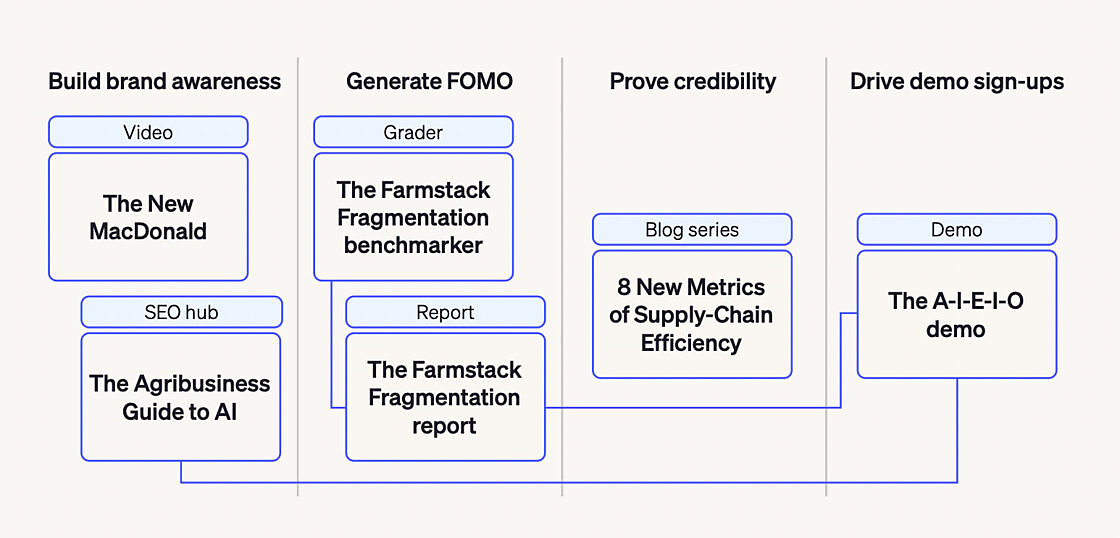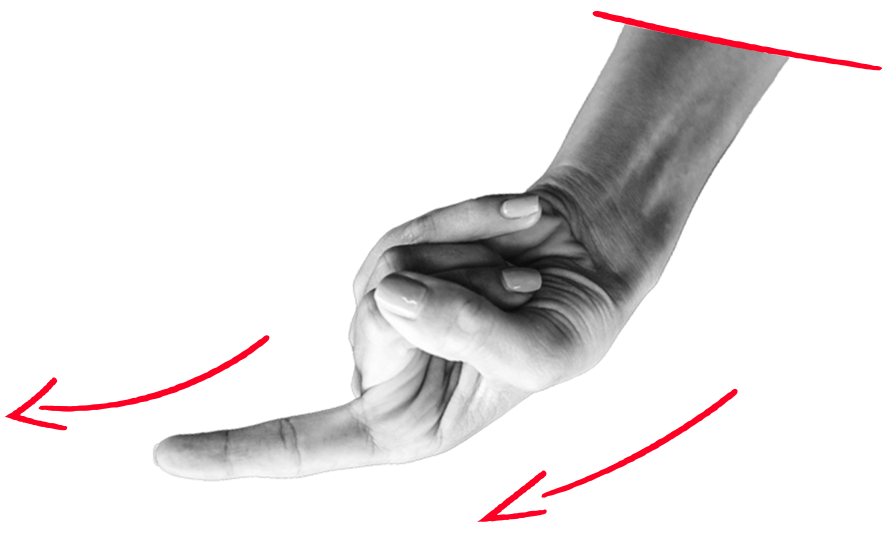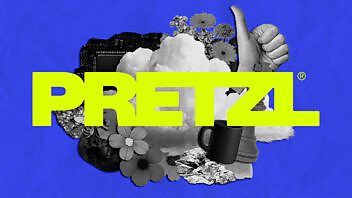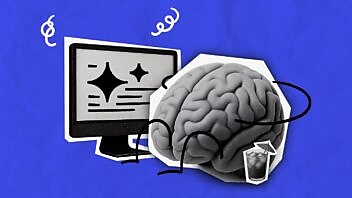In our Big Beautiful B2B Blueprint, we posited that the first step to creating some killer ideas is to forget about the marketing funnel. Sure, it’s a neat little metaphor. But B2B marketing is anything but neat.
The funnel is a useful concept when it stays in its lane. You can use the funnel to illustrate why B2B buying involves multiple stages of consideration. And terms like “Top/Bottom of funnel” are useful shortcuts to brief creative teams on messaging altitude.
The problem is that the funnel metaphor implies prospects move in a logical order through a linear sequence of stages from awareness to consideration.
Here’s how we describe the issue on page 40 of the blueprint.
While the funnel doesn’t capture the messiness and unpredictability of the buying journey, the bigger issue is that it lets us off the hook on thinking. Filling the funnel isn’t a strategy.
Forget the funnel
When marketers talk about “pushing” people through the funnel, the oversimplified metaphor leads them in the wrong direction. It’s too easy to overlook the fact that no buyer wants to be pushed through anything. Especially when that something ends with an unwanted sales call. (Which, let’s face it, is any cold sales call).
There’s no pushing in B2B marketing; there’s only courting. Buyers have their own process, and if you’re not courting them with truly helpful ideas, you’re probably not going to get the chance to influence that process.
Jon Miller agrees that we’ve overindexed on the funnel. He wonders if the next metaphor is from chemistry or physics: moving customers outward — towards advocacy — requires energy input. And the closer you get toward conversion, the more energy it requires.
I think most smart marketers can feel the funnel isn’t right, but don’t always have the language to say ‘Hey, not that, but this.’
So here’s an alternative we sometimes use — a framework that you’ve undoubtedly heard of before, but with a little extra nuance around thinking from two perspectives: first, what you need as a marketer, and second what your customer needs as a buyer.
The ideal outcome is there’s overlap between the two, and that in the overlap you find new, killer ways to achieve your goals while empowering your customers.
Jobs to Be Done
The Jobs to Be Done (JTBD) framework is nothing new. It’s built around the idea that customers buy a product or service to get a ‘job’ done.
But when applied to content strategy, we like to think of it in two stages. It’s a helpful perspective shift for marketers trying to put customer needs at the center of their decision-making, without a big leap into the unknown.
Firstly, it’s about how the framework serves marketers. It means forgetting a funnel-esque, linear journey in favour of key moments. Instead of thinking ‘what do we need to create?’, it’s about thinking ‘what specific activities will grow demand and accelerate buying decisions?’
Thinking about your own goals is a great place to start with a JTBD model. In the case of our Big, Beautiful Blueprint, these were inflection points such as ‘grow awareness,’ ‘build FOMO’ and ‘prove credibility,’. You can then think about the specific jobs of content assets in achieving those goals, rather than just creating a bunch of stuff and hoping something sticks.

The second stage is thinking about how the framework serves customers. It’s not such a big leap from funnel logic to marketing-centric JTBD, but the next step is about applying this mindset to what customers are actually trying to achieve. This is never ‘buy this product,’, but something more like:
- Close a capability gap
- Create advantage
- Drive efficiency
- Solve a specific problem
- Compare vendors
- Prove the business case
- Quantify upside
- A bunch of others
The structure is simple. The hard part — where you come in — is the creative thinking.
You need to define what your customers are actually trying to achieve and think about how marketing can help. Because what you need from customers and what they need from you can be very different. This framework advocates for their goals before marketing brain gets in the way.
A marriage of marketing and customer goals
This is one of those concepts that’ll be easier to explain with examples, so let’s dig in to a few.
Example 1: Exploring the problem space (or “Why act?”)
You offer the only solution to a certain problem, but your prospects don’t know they have a problem at all. To them, maybe it feels more like a lot of smaller, unrelated problems or “just the way things are,”, or they have other problems they care about more.
From a marketer-centric perspective, your first priority is to create content that romances that problem — to build not just awareness of the issue, but urgency to solve it.
From a customer-centric perspective, the JTBD is helping buyers feel confident that they’re prioritizing something critical, and investing time and resources where they’ll have the biggest impact. That’s about strong beliefs as much as objective information — you’re making a case that this thing is more important than that thing.
Example 2: Evaluating the options (or “Why you?”)
Let’s say your prospects know they have a problem and they’re aware you solve it — but your competitors claim to offer the same big benefits you do, for less money. They even steal your language. (This is a real client problem we’re working on right now).
From a marketer-centric perspective, this is a differentiation problem. The devil is in the details, but the details are very technical. The job of your content is to differentiate the offer — to get your buyers interested and informed enough to understand and care about the specific stuff you do best.
But from a customer-first perspective, it’s a vendor assessment problem — they want to know how to distinguish between superficially very similar offers. Truly helping customers at this stage might mean talking as much about your competitors as your own offer. Does this risk turning folks to other solutions that suit their needs better? Yes. Does it also help you sell more effectively to a tighter ICP? You better believe it.
Example 3: Doing something about it (or “Why now?”)
Now imagine your performance team notices a trend (they’re always doing that). A cohort of recent customers all followed a defined content journey (one of the custom metrics we measure on page 65 of the blueprint) before taking a commercial action — say, bouncing from a blog post to a product page, to a pricing page, to a contact form.
You have evidence that when a certain group of customers follows a given sequence, they’re likely to engage. Now the job is to entice similar customers (like a lookalike segment) to the first step of that proven journey.
In this case, a marketer and customer-centric goals are perfectly aligned — you’re giving customers what they need to act, and they’re putting their hands up and becoming quality leads.
The creative platform and Jobs to Be Done
The next time you’re thinking about content strategy, try starting out by answering these questions:
Marketer-centric JTBD
- What are our most urgent opportunities?
- How could marketing help unblock them?
- What is the fastest path to the highest number of the most mature commercial conversations?
- How can you interlink content ideas and program ideas?
Customer-centric JTBD
- What are the most urgent problems to solve?
- Where are customers missing critical information?
- What will bring the most benefit quickly to customers looking to buy?
- How can you make it easier for customers to consume your content?
A customer-centric JTBD focus can take more patience than a marketer-centric approach, because you’re putting your buyer’s needs before your own. But creating value for prospects is an investment, not an expense, and in the long term, it’s a path to get your brand associated with solving problems potential buyers care most about.
The Big, Beautiful B2B Blueprint encapsulates every bit of advice we have about how to do it — in a logical, fill-in-the-blanks format. Check it out. (Don’t worry, we’d would never try to push you through a funnel or, heaven forbid, call you).
Once you’re looking to get your ideas going, we’ve also got some handy pieces on making your marketing more effective with better connected teams and how to come up with the most impactful campaign ideas.
Have you used a model like this? Thinking about trying it? Share your experiences in the comments.

Enjoyed this article?
Take part in the discussion








Comments
Dave January 16th, 2025
I really enjoyed this post. The model you call out is very similar to a model by a company named Corporate Vision. They have a similar framework of Why Change, Why Now, Why You. Just bringing it up because your model resonates with me.
My biggest challenge is that I try to put our content into those boxes and then fall into analysis paralysis determining in which box it fits. Your notion of a content path shook me out of that as in the end although we can generally categorize the content the fact that a buyer is taking a deeper action (looking at service pages, looking at pricing models, taking an assessment) are the real signals that a buyer is more or less interested in buying.
Thanks for the great article and love the sassy attitude.
Lisa Dare January 17th, 2025
First of all, Dave, “sassy attitude” is the nicest thing anyone has said to me in awhile and you are my new favorite person.
That’s interesting about analysis paralysis. That’s part of the problem —- the funnel concept makes smart people fight their own instincts. You know the content you want to build has a purpose but it doesn’t always fit this exact pattern.
I agree, we still look at the funnel as a way to make sure we’re not missing key pieces someone might need in their decision-making process. But our performance people tell us the funnel is mostly a myth anyway, especially the idea that prospects are following any kind of linear path.
Jeff February 4th, 2025
Just thanks, really. This is a terrific post, wonderfully written. I’m working with an org now that desperately needs a customer-centered approach and this piece will be lovely ammo as I meet with my director to talk strategy later in the week. (Aside: The “jobs to be done” idea prompted me to rewatch the Clay Christensen clip on the job of a milkshake.) — Cheers …